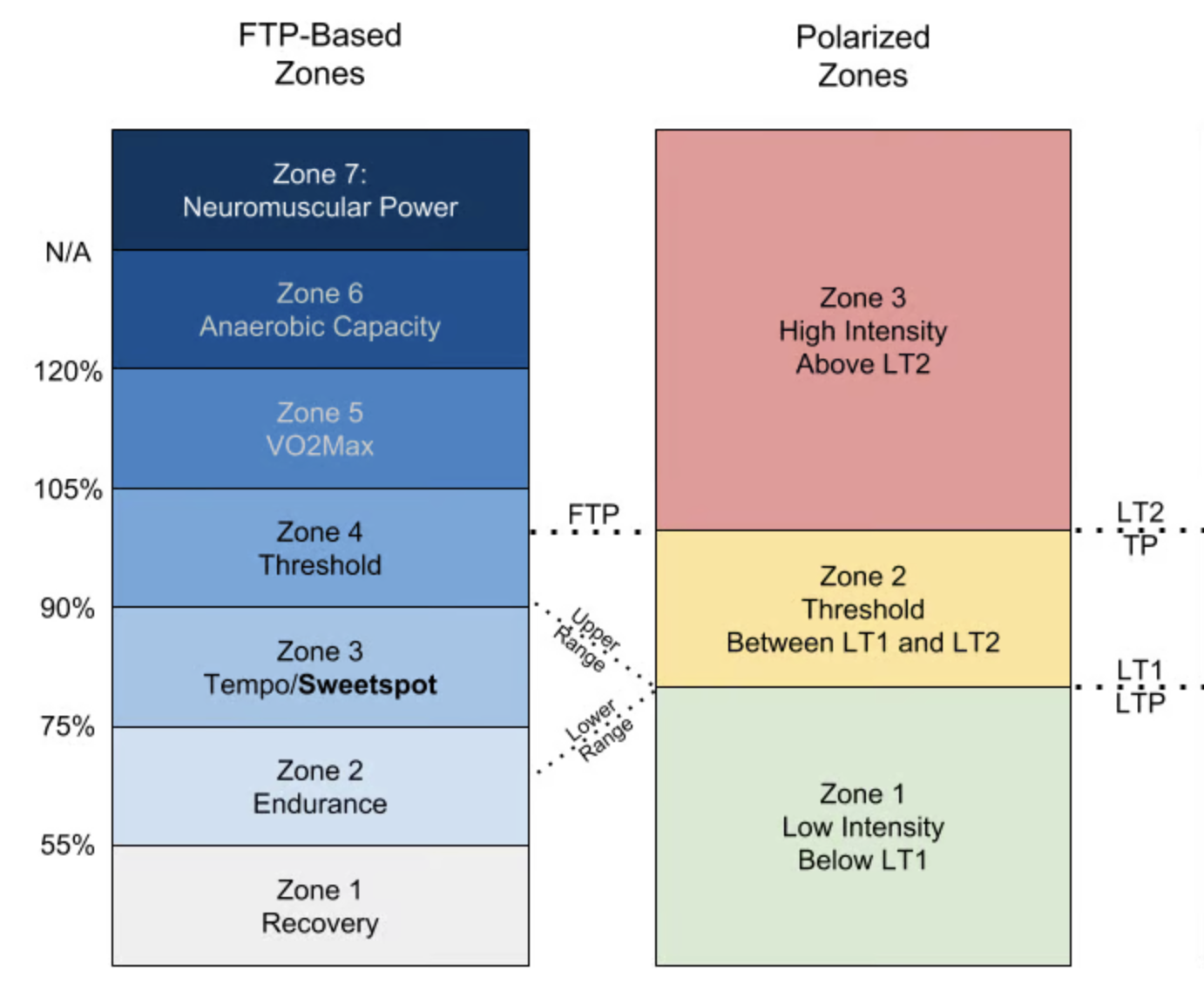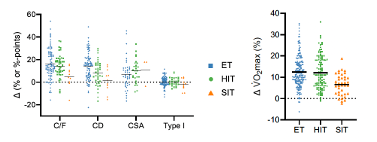In the world of amateur running and other age-group endurance sports like cycling and triathlon, the gospel seems to be that “Zone 2” is the key. I keep getting asked why I’m skeptical of this mantra, so I thought a brief overview of the evidence might be handy. There’s also a fantastic narative review article which is well worth a read.
The tl;dr is that the simple version of Zone 2 being popularised by influencers and podcasters isn’t actually delivering what we think it is. And there’s a few reasons for this.
“Zone 2” isn’t what you think it is
The term “Zone 2” has gained massive popularity in fitness circles , often loosely defined in popular media as the intensity for maximal fat burning (or a low blood lactate concentration).
The greatest source of confusion is the clash between the precise language of exercise physiology and the simplified metrics on your Garmin or Zwift screen. In exercise science, intensity domains are rigorously set by physiological thresholds that mark metabolic ‘breakpoints’. And there are only three of them.

Zone 2 scientifically is the intensity of exercise performed between lactate threshold one (LT1, or lowest exercise intensity at which there is a measurable increase in blood lactate concentration, yet lactate levels remain in a steady state) and lactate threshold two (LT2, also known as the anaerobic threshold or just “lactate threshold”, the point where lactate concentrations will rise over time).
However, this isn’t how your training platform of choice treats it. Garmin has five zones. Zwift has six. Strava, Intervals, and TrainerRoad use seven. And whereas the scientific definition is based on physiological markers (either measured directly, or using ventilatory equivalents), wearables and simple training programmes almost always rely on fixed percentages of an easily obtainable maximum value (like maximimum heart rate, or FTP which itself is non-trivial to actually estimate) to draw its boundaries.
As such, the popular media-driven definition of Zone 2 typically corresponds to a fixed HR range (e.g. 70%−80% of maximum HR for Garmin)), but research consistently shows that simple, standardized metrics are highly inaccurate for prescribing an individual’s true metabolic threshold. Even among trained amateur cyclists, a fixed Zone 2 prescription (e.g. %HRmax or %FTP) can place different individuals in very different metabolic intensity domains. This is because athletes vary widely in underlying physiology, such as mitochrondrial density, lactate kinetics, oxygen transport efficiency, and muscle fiber composition. So if there is a benefit of Zone 2 training specifically, many aren’t actually going to be working there.
“Fat Max”, or exercise intensity that induces maximal fat oxidation, is another rationale used for Zone 2 training. However, attempting to target this physiological point using a fixed heart rate percentage is similarly unreliable. Not only is there substantial disagreement between Fat Max and fixed heart rate targets, but Fat Max is generally around 25% lower in power output than the LT1, demonstrating that the two commonly linked concepts are metabolically distinct intensity domains.
So when you’re targetting zone 2 on your watch or a Zwift workout, you’re probably not actually in zone 2… by any definition!
How muscles adapt, and why they don’t care about zones
Adaptation in skeletal muscle begins at the molecular level. Exercise intensity generates specific intramuscular signals that initiate remodeling.
High-intensity and long-duration efforts activate signaling cascades through energy depletion (rise in the AMP/ADP:ATP ratio), increased calcium flux, and changes in the redox balance. These signals activate regulators like AMPK and CaMKII, which upregulate the transcriptional regulator PGC-1
Capillary growth (angiogenesis) is primarily influenced by increased blood flow (causing shear stress on endothelial cells) and mechanical stretch. This process is mediated by the secretion of Vascular Endothelial Growth Factor (VEGF).
Both these mechanisms are independent of the type of exercise stimulus. There isn’t a special molecular mechansism that only works at low intensity - the body has one response to the stress of exercise, so it makes sense that the more intense that stress, the higher the response.
We typically measure exercise as “training volume” = intensity
That’s exactly what a large meta-analysis of training styles found. But while all intensity categories (low intensity endurance, moderate intensity HIIT, and high intensity sprint intervals) increased mitochondrial content to a similar extent after adjusting for total training sessions, their efficiency per hour varied drastically.
What’s more, the study looked at not only the tissue responses to exercise (capilliary and mitochondrial density), but the end result in terms of performance, measuring improvements in VO2max which reflects aerobic capacity. Sprint training was a staggering 3.9x more efficient per hour at improving mitochondrial density, and an even more impressive 4.9x more efficient at improving VO2max than endurance training (the classic “Zone 2” beloved of influencers). HIIT sat in the middle, around 1.7x more efficient than endurance work.

So the evidence is clear - as a time-crunched athlete with limited time to train, working harder is working smarter. You’ll adapt around 5x faster through doing sprint intervals than spending hours pounding the pavement in what your watch claims is zone 2, but is in all likelihood way below even LT1.
But the pros do it!
Despite this, the “polarised” training model using high Zone 2 volume, is overwhelmingly used by elite endurance athletes who train for 20 hours or more per week. However, this doesn’t mean that it’ll work for you, any more than you should consume 120g/hour of carbs.
For a professional, the massive volume of low-intensity training is the safest, most “cost-effective” way to achieve necessary training loads and fundamental aerobic adaptations (e.g., mitochondrial and capillary growth) while minimizing accumulated systemic stress. The low stress of true Zone 2 training aids recovery, ensuring they can perform the few high-quality, high-intensity sessions (the 20%) that actually drive performance peaks.
They also do Zone 2 properly. There’s the infamous Peter Attia interview with Tadej Pogacar that keeps getting clipped up on Instagram and TikTok:
The clip always misses the next part - where the greatest cyclist of all time says he can be too tired after a Zone 2 session to ride the next day so has to reduce the power: “five hours of riding 320-340 watts for me also means that the next day I’m not riding my bike”. That suggests he’s riding in the scientific Zone 2, rather than “a brisk walk to the shops” like Huberman claims constitutes Zone 2.
There’s also other advantages for spending hours on the bike when you’re literally paid to spend hours on the bike. Handling skills, learning routes, and just exposure for the sponsors. And maybe some specific adaptations regarding MCT1. But the few hours the pros spend in higher zones is doing the bulk of their aerobic adaptation; the rest if just polishing because they have the time do so.
The luxury of time is precisely why the polarised model is less practical for the average age-group athlete. If you only have three to four hours per week to train, spending 80% of that time in a truly low-intensity Zone 2 may not provide the minimum effective stimulus needed to elicit maximum physiological adaptations. There is also evidence that there is a minimal intensity stimulus required to produce meaningful increases in VO2max, and training the true “Moderate-Intensity Domain” (MOD) i.e. below LT1 produces no significant benefit.
For the time-crunched athlete, the priority should be time efficiency. Since high-intensity training is significantly more efficient per hour, prioritising work at or above LT1 and ideally LT2 is critical for maximising fitness gains.
But you said “long live Zone 2” in the title?
Although focusing purely on Zone 2 for maximal gains in aerobic adaptation is sub-optimal for the time-crunched athlete, training at this intensity still provides specific benefits.
Zone 2 exercise enhances the capacity for fatty acid oxidation (FAO). Improving FAO capacity is strongly correlated with cardio-metabolic health and better endurance performance, as it spares valuable carbohydrate stores. Training at Fat Max does appear to increase fat oxidative capacity, particularly in previously sedentary or untrained populations. However as said above, HR or power equivalents for this are probably inaccurate, so it’s worth getting this measured properly.
And while all intensities increase capillaries per fiber similarly, endurance training is slightly more effective at increasing capillary density (capillaries per mm
But most importantly, Zone 2 training minimises fatigue accumulation and allows for overall higher training volume and consistency. There’s benefits in running or riding long distances in terms of improving tendon strength and flexibility, and in learning how to psychologically handle these. The weekly “long run” and/or “long ride” is a staple of any training plan not because it has a huge beneficial effect on your aerobic engine, but because it allows you to experience what you’ll feel like hours into a race.
So what does this all mean?
Trusting the simple, one-size-fits-nobody “Zone 2” on your smartwatches is pointless. Spending the bulk of your time training here almost certainly fails to deliver a reliable physiological stimulus to improve your fitness, at least over a reasonable timescale. However, the concept of low-intensity training still remains crucial - just for other reasons.
For the everyday, time-crunched amateur runner or age-group triathlete I’d recommend finding your true thresholds. Your Zone 2 limits must be personalised, ensuring that you target the right intensity domain that you’re after, rather than accidentally drifting into the higher, fatiguing domains if trying to go easy or not achieving any gains at all if trying for a true Zone 2. It may be that you actually want to be in the scientific Zone 1, especially if you’re focussing on time at Fat Max… In which case you need to know your LT1 and how to get below it.
But more importantly, prioritise efficiency over volume. Given the time constraints we all face, you’ll get the maximum gain if focus your limited training time on high-intensity efforts.
However if you want to also use lower zones, then use them strategically. Save true low-intensity work for dedicated recovery sessions or long rides/runs that build mental and physical resilience (and possibly enhance FAO), or as the active recovery within your high-intensity interval workouts.
But mostly, ignore the influencers. A brisk walk to the shops is good if you never do any exercise, but if you already run, swim, or cycle you’re never going to see your VO2max improve that way.

